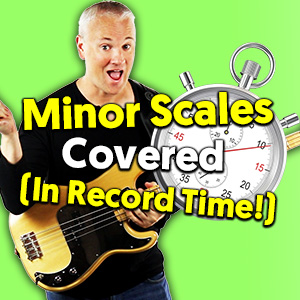This week I’ve got a brief, simple exercise for you that will test your knowledge of keys, arpeggios and harmony. I personally think that less than 1 per cent of bass players will play it right on the first attempt simply because it isn’t the kind of exercise we generally practice.
Obviously, any player with a decent knowledge of harmony will play the exercise with ease and there may be many more players in that subset than I predicted. Let’s see!
Clickbait…Moi?
Now I know what you’re thinking. What’s with the stupid clickbait title?!
Well I want you to be completely honest when I present this challenge. Can you play it on the first attempt? This isn’t a technical challenge, the exercise is physically easy and I assume nearly all of you CAN play it.
This is tougher from an all round knowledge and musicianship perspective. If you have a good enough understanding of chord construction the major scale and perhaps even the modes it’ll be easy. If not you’ll run into problems almost instantly and probably give in.
I want you to be honest and let me know in the comments if you can play it on your first attempt. No practice. No tab. No sheet music. Just “Here’s the exercise now do it” based on your harmony knowledge and understanding of arpeggios.
I personally think that less than 1% of bass players will get it right first time.
So here’s the exercise. I want you to play the fully extended diatonic arpeggios of the major scale from root to 13th and back. So let’s take the key of C major. That’s going to be Cmaj13, then Dm13, Em13b9 and so on. These are fully extended so I want the root, 3rd, 5th , 7th, 9th, 11th and 13th for each one. Each extension has to be diatonically correct. So in C major, the F chord will be an Fmaj13 with a #11. The B chord will be a Bm7b5b9b13. All of the modal considerations have to be intact.
The Challenge
This exercise is as follows:
Play through each diatonic 13th arpeggio of the major key
That’s it. But this exercise is much tougher than you might first think (see video for the playthough)
Can You Do It?
So be honest, can you play that on your first attempt. Or even your second, third or fourth attempt. I suspect maybe even the majority of you will be unable to play it at all without some serious study and improvement in terms of harmony and arpeggio knowledge.
Let me know in the comment section below
Arpeggios
When we build chords in general western music, we build them by stacking thirds. This is called Tertian harmony.
Now I’m not going to get too far into this because it’ll take one hell of a long lesson to explain the whole system. I’ve got other lessons on Youtube covering chord construction and if you want to understand all of this in depth then I have the Chord Tone Essentials course. In that course I work through the construction principles of every chord you’ll ever encounter, how to play them all over the fretboard and how to apply them in your music. So if I’ve perked your interest just go check that out.
As a simple example here are all the basic natural extensions of a Cmaj7 chord (9th, 11th, 13th):

Be sure to learn at least the four most common seventh arpeggios – Major 7, Dominant 7, Minor 7 and Minor 7b5 – and then learn the natural extensions for each one – Major 9th, Perfect 11th and Major 13th.
Once you have the natural extensions under your fingers you can add the altered extensions and you’ll be good to go!
Diatonic Arpeggios
For our exercise we have to be able to create arpeggios diatonically from our parent major scale.
As an example, let’s look at the basic triads we can create from our major scale. Let’s take the notes of our C major scale.
C D E F G A B
If we build a chord starting on a C we can just work up through those notes in thirds. So we start with a C, then count up 3 notes to E, then up another 3 notes to G. That gives us the notes C E G – The C Major Triad.
We can continue this process through the scale giving us the following chords:
- C E G B – Cmaj7
- C E G B D – Cmaj9
- C E G B D F – Cmaj11
- C E G B D F A – Cmaj13
We can then apply the same method to every note in the major scale. If we start on a D we stack our thirds using the notes of the C major scale giving us the following chords:
- D F A – Dm
- D F A C – Dm7
- D F A C E – Dm9
- D F A C E G – Dm11
- D F A C E G B – Dm13
So this is how our exercise works we just repeat this process for every degree of the major scale. Which gives us the following set of fully extended chords in C Major:
- C Major 13
- D Minor 13
- E Minor 11 b9 b13
- F Major 13 #11
- G13
- A Minor 11 b13
- B Minor 7 b5 b9 b13
The Complete Exercise
So if we now play through those arpeggios in the key of C major, we get the following:
CMaj13

Dm13

Em11b913

Fmaj13#11

G13

Am11b13

Bm11b5b9b13

As always you want to be able to play this exercise in any key, so you could work through the cycle of fourths. This gives us the order of keys:
C F Bb Eb Ab Db Gb B E A D G
The Next Step
The key to learning this exercise is understanding the core elements of harmony we’ve looked at. Don’t try to learn the exercise simply as a finger exercise or as a basic line. The exercise is more of a test of your underlying knowledge and you should strive to be able to play through these kind of exercises on the fly, relying on your overall musicanship.













Awesome..and very challenging..thanks bro..
awesome
I really enjoyed this exercise! Thank you!
Not a chance in hell…
If I knew what a “fully extended diatonic arpeggio” was, I might be in with a chance.
And what’s a 13th? I’m off to try to study some basic theory. lol
It’s been a year, but a 13th is just the 6th an octave higher from your starting point, just like the 9th is the 2nd one octave higher and the 11th is the 4th also on the octave above
Dude… I play bass for ~20 years, I recorded albums but I’m self thought so no much of theory & “brain”…
This exercise really making me brush-off the rust! HUGE THANK YOU! :)
I didn’t have a clue. It’s a learning curve. And for me that is where the juice lies. Music to me is an ever evolving always fun fluctuating learning curve. And there are no real short cuts to consistent disciplined practice irrespective of how talented one is. This was extremely useful. Thank you Mark.
Egffflp
ing.sortino@gmail.com
:
A subject I’m totally missing, this lesson will take me forward
Of course I know my appergios ‘methinks!’
But the truth was soon revealed when this exercise made me feel so DUMB! In fact the exercise proved to be a great ‘Lie Detector’ test…but so much fun!. Anyway, it’s tail between me-legs and back to the basics again for me! Thanks a million :)
Not a chance! I need to study a lot more theory first!
Knew my arpeggios across the modes to the 7ths very well, (9th for ionian) so could not do the exercise to 13ths.
Have ionian and aeolian sorted to 13ths now, will be working on the rest.
My 5 string is proving very useful for this exercise, less shifting required.